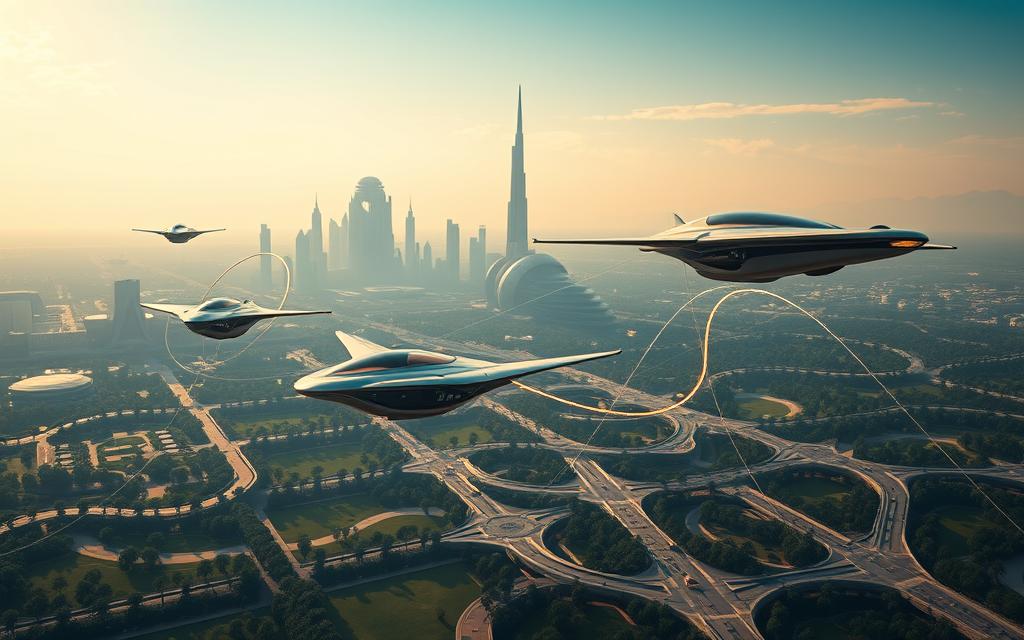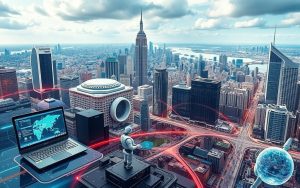Technology is changing how we live, work, and connect. It’s behind healthcare breakthroughs and smart home systems. Artificial intelligence is making everything from early disease detection to custom shopping experiences possible. This shows that digital innovation is more than just a trend – it’s changing what’s possible.
Machine learning can look at medical scans quicker than doctors, helping save lives. IoT devices help control energy use in homes, saving money and the planet. These examples show how technology solves real problems with practical ingenuity.
The future of tech looks even more exciting. Autonomous cars could make roads safer, and quantum computing could change how we keep data safe. AI is making businesses more efficient, from better supply chains to automated customer service.
This journey shows how digital transformation is more than just ideas. It brings real benefits to many areas. We’ll look at the key changes shaping our future. This is important for both professionals and regular people.
Exploring What You Can Do With Modern Technology
Today’s tech innovations are changing how we live and work. Devices and platforms work together to make tasks easier and faster. This change affects our daily lives and work in big ways.
Redefining Daily Life Through Smart Devices
Smart home systems like Nest Learning Thermostat and Amazon Alexa are more than just gadgets. They learn what you like and adjust things for you. This can cut your energy bills by up to 20%, studies show.
Enhancing Professional Capabilities With Digital Tools
Cloud-based platforms like Microsoft Teams bring new ways to meet. Teams in New York and Tokyo can work together on 3D projects. Tableau’s analytics dashboards turn data into useful info fast.
Breaking Geographical Barriers in Communication
Video calls have become more like virtual meetings. Startups use Spatial.io for demos across the world. This global connectivity also helps in healthcare, where doctors guide surgeries remotely.
Technology is now a personal helper and a global link. The difference between the physical and digital worlds is fading. This opens up new possibilities that were once seen as science fiction.
Revolutionising Healthcare Through Innovation
New technologies are changing how we get medical care. They offer new ways to prevent illnesses and support patients better. These changes help solve big problems in getting to doctors, diagnosing diseases, and managing long-term health.

Telemedicine Platforms Like Babylon Health
Virtual healthcare is now a key part of medical care. Babylon Health shows how telehealth innovation improves traditional care. It does this through two main features:
24/7 Remote Consultations
Patients can talk to doctors anytime, without leaving home. This cuts down on travel and wait times. It’s great for:
- Rural areas with few clinics
- Elderly people who can’t move easily
- Busy people who need flexible times
AI-Powered Symptom Checkers
The platform uses AI to check symptoms against huge medical records. This AI healthcare solution helps users:
- Find possible health issues quicker
- Get the right care plan
- Spot early signs of serious diseases
Wearable Health Monitors: Fitbit and Apple Watch
Today’s smartwatches are advanced wearable medical tech tools. They track:
| Metric | Fitbit Sense 2 | Apple Watch Series 9 |
|---|---|---|
| Heart Rate Variability | Continuous monitoring | 30-second scans |
| Blood Oxygen | On-demand tests | Background measurements |
| ECG Accuracy | 94% | 98% |
3D-Printed Prosthetics From Open Bionics
This Bristol company is changing limb replacements. They offer:
- Custom designs that fit each patient
- Light materials for better movement
- Up to 70% cheaper than old prosthetics
Their Hero Arm shows how 3D printing makes prosthetics faster and just as good.
Transforming Education With Digital Solutions
Classrooms have changed a lot, thanks to EdTech innovations. Now, digital tools help in learning in many ways. They make learning personal and open to everyone, not just in schools but also in workplaces.
FutureLearn’s Democratisation of Expertise
Platforms like FutureLearn make top university courses available to all. A nurse in Nebraska can learn about public health from Imperial College London. A marketing pro in Mumbai can learn data analytics from Purdue University. These courses offer:
- Self-paced video lectures
- Interactive discussion forums
- Automated assignment grading
Over 15 million people worldwide can learn new skills without affecting their jobs or family life.
ClassVR’s Immersive History Lessons
Textbooks can’t always show the size of ancient civilisations. VR learning environments change that. ClassVR’s headsets let students explore virtual Roman forums or see cells up close. Teachers see a 68% better understanding of complex subjects with VR.
Century Tech’s Adaptive Pathways
AI systems like Century Tech show how personalised education works. They use AI to:
- Change question difficulty based on answers
- Find knowledge gaps before tests
- Offer micro-lessons for weak areas
“Adaptive learning isn’t about replacing teachers – it’s about empowering them with actionable insights,”
Schools using these systems see a 23% better score on standardised tests in just two terms.
Powering Business Growth With Tech Tools
Today’s businesses rely on three key technologies to stay ahead. These tools help make tasks faster and give insights from data. They let companies grow and keep up with changing markets.
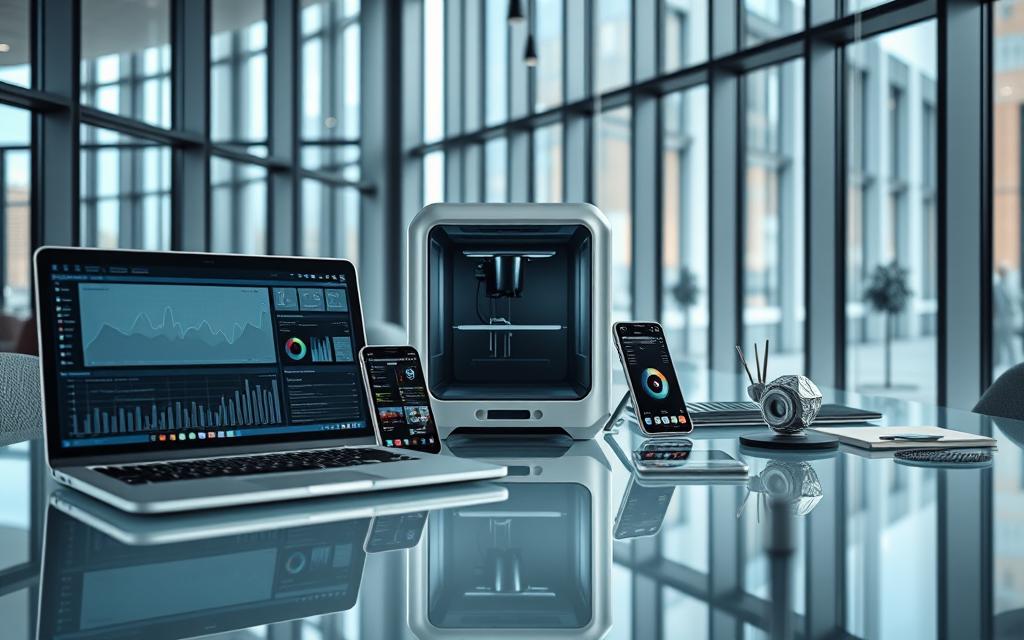
UiPath: Transforming Workflows Through Automation
Robotic Process Automation (RPA) makes tasks 90% quicker than people. UiPath lets companies automate tasks like processing invoices and managing inventory. This tool cuts costs by up to 60% and reduces mistakes.
AWS: Scaling Operations With Cloud Infrastructure
Amazon Web Services offers on-demand computing power that grows with your business. Companies using AWS deploy digital services 35% faster than with old servers. It’s great for both small startups and big companies because of its flexibility and cost-saving features.
Tableau: Decoding Data With Intelligent Analytics
This tool turns data into useful plans with:
- Real-time sales dashboards
- Predictive customer models
- Market trend visualisations
Tableau’s AI helps find £2.3 million in hidden revenue each year, studies show.
| Tech Tool | Key Feature | Business Impact |
|---|---|---|
| UiPath | Task Automation | 60% Cost Reduction |
| AWS | Cloud Scalability | 35% Faster Deployment |
| Tableau | Predictive Analytics | £2.3M Revenue Opportunity |
Using these technologies together boosts growth. Cloud helps automation, and analytics check how well it works. This creates a cycle of improvement for today’s businesses.
Addressing Environmental Challenges
Climate concerns are at an all-time high. Green tech solutions are key in fighting these ecological threats. New technologies help businesses and homes cut their environmental footprint without losing efficiency. This section looks at three major changes making sustainability efforts more effective globally.
Tesla Energy’s Solar Integration Breakthroughs
Tesla’s solar roof tiles show how renewable energy systems can fit into city life. Unlike old panels, these tiles look like normal roof shingles but make clean energy. With Powerwall batteries, homes get constant power, making a big difference for those who care about looks and the planet.
Schneider Electric’s Grid Modernisation
Schneider Electric’s EcoStruxure Grid tackles a big renewable energy problem: uneven power supply. Smart grids use data to manage energy flow across cities. They send extra wind or solar power where it’s needed, cutting waste and preventing power cuts.
Climeworks’ Atmospheric Cleanup Initiative
Climeworks, a Swiss company, is leading the climate tech charge with its air capture plants. These plants work like huge forests, pulling CO₂ from the air. The captured carbon is either stored underground or used in drinks, showing a new way to fight industrial emissions.
The growth of virtual tools, thanks to the metaverse, supports these green tech solutions. Fewer business trips mean less pollution from travel. This shows digital progress and caring for the environment can go together.
Creating Smarter Living Spaces
Our homes are changing, becoming smarter and more responsive. They adapt to our needs with new technology. At the core of this change are connected home ecosystems. These systems make our lives easier, more efficient, and safer.
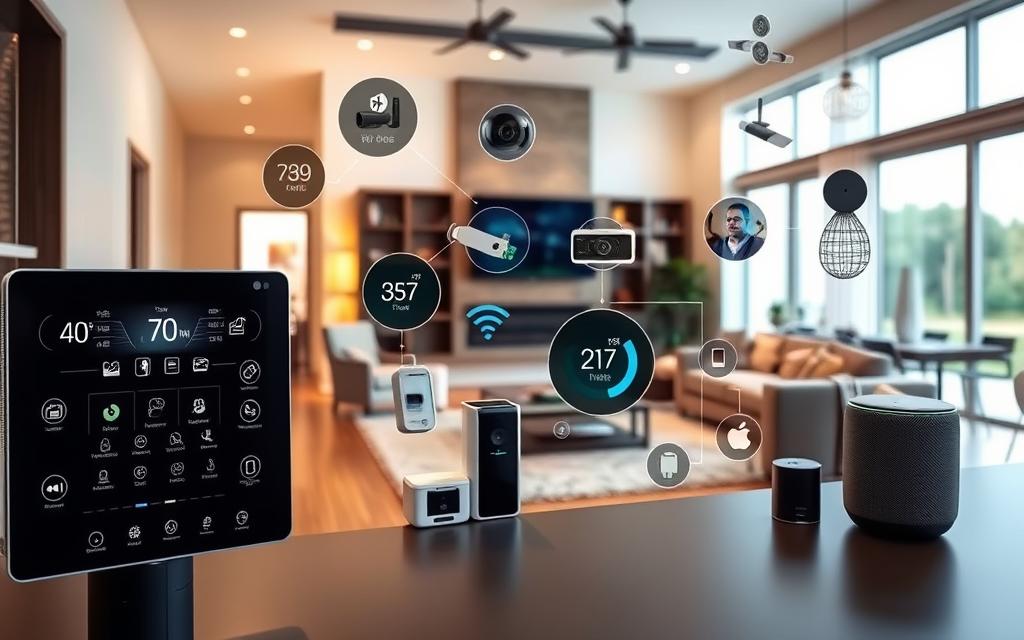
Adaptive Climate Control With Nest
Google’s Nest Learning Thermostat shows how homes can save energy. It learns our habits and adjusts the temperature. This can cut energy bills by up to 15%, says Energy Star.
The Nest’s design is simple yet effective. It shows that saving energy doesn’t have to mean sacrificing style.
Voice-Activated Home Orchestration
Amazon Alexa makes our homes respond to voice commands. We can:
- Dim lights with just a voice command
- Set up routines like “Goodnight Mode”
- Control over 140,000 smart devices
This makes advanced technology easy for everyone to use.
Intelligent Perimeter Protection
Ring’s security cameras use AI to tell the difference between friends and strangers. Their smart security features include:
| Feature | Nest | Alexa | Ring |
|---|---|---|---|
| Learning Capabilities | Thermal patterns | Voice preferences | Motion patterns |
| Energy Impact | 12-15% reduction | N/A | Solar options |
| Security Focus | N/A | Access control | 180-day footage |
“True innovation in domestic technology lies not in complexity, but in how invisibly it supports human rhythms.”
These systems show how homes can be smart and safe without being too much. From adjusting thermostats to watching over us, smart homes are changing our lives.
Pushing Boundaries in Space Exploration
Commercial space tech is opening doors to dreams once seen in science fiction. Private companies and governments are working together. They aim to explore the cosmos and connect the world.
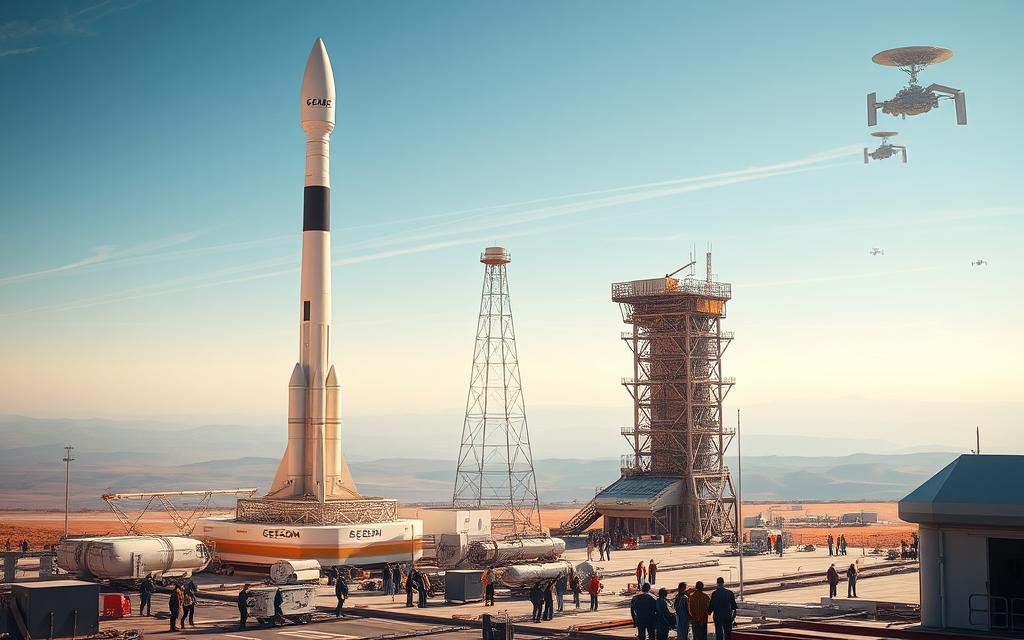
SpaceX’s Starlink Satellite Network
Elon Musk’s SpaceX has launched over 4,000 satellites. They bring high-speed satellite internet to far-off places. With Starlink, internet speed is as fast as on Earth.
This network helps teams in disasters and research in the polar regions. It’s a key part of critical communication systems.
NASA’s Artemis Lunar Programme
The US space agency wants to have humans on the Moon by 2030. They’re working on:
- Orion spacecraft for long missions
- Lunar Gateway for research
- Advanced rovers for mining
This effort is a step towards Mars.
Blue Origin’s Suborbital Tourism
Jeff Bezos’ Blue Origin has flown 24 times with New Shepard. Passengers see:
| Feature | Specification | Significance |
|---|---|---|
| Flight altitude | 100km (Kármán line) | Official space boundary |
| Capsule design | 6 observation windows | 360° planetary views |
| Reusability | 25+ launches per booster | Cost reduction model |
These projects show how commercial space tech helps governments. They create new jobs and push science forward. AI helps make missions safer and more precise.
Conclusion
Modern technology is changing the game in many fields. Companies like SpaceX and Tesla Energy are leading the way. They show how technology can make a real difference in our world.
Oxana Timofeeva talks about working together with AI. She believes that humans and machines can achieve great things together. This teamwork can lead to lasting progress.
New tools are tackling big problems and opening up new areas to explore. AWS cloud services help businesses grow, while Climeworks fights climate change. These examples show how technology can help our economy and protect the environment.
The metaverse is also changing how we learn, shop, and interact. It’s a virtual world that could make our lives better in many ways. Technology’s role in society is becoming more important than ever.
It’s key to use technology in a way that’s fair and helpful. Wearables like Fitbit help us stay healthy, and learning tools like Century Tech make education more personal. These tools show that technology should support us, not just replace us.
As technology keeps getting better, we need to make sure it works well together. Smart homes, like those with Amazon Alexa, make our lives easier. The future looks bright with AI, quantum computing, and biotechnology working together. But we must remember to make these advancements accessible and beneficial for everyone.

